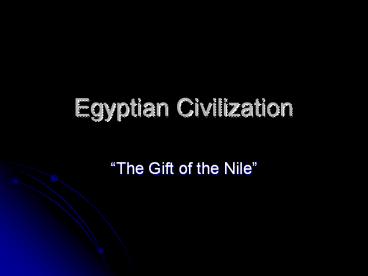Egyptian%20Civilization - PowerPoint PPT Presentation
Title:
Egyptian%20Civilization
Description:
Title: Slide 1 Author: Brad Berghoff Last modified by: bberghoff Created Date: 9/12/2006 3:07:35 AM Document presentation format: On-screen Show (4:3) – PowerPoint PPT presentation
Number of Views:151
Avg rating:3.0/5.0
Title: Egyptian%20Civilization
1
Egyptian Civilization
- The Gift of the Nile
2
Nile River
- Begins in heart of Africa and runs over 4,000
miles - Northern part- Lower Egypt
- Southern part- Upper Egypt
- Flooding-Agriculture, 10 mile wide Black Land,
Red Land - Natural Barriers
3
(No Transcript)
4
Course of Egyptian History
- Menes- king who united Upper and Lower Egypt into
single kingdom-3100 BC - First Dynasty
- First capital at Memphis
5
Old Kingdom
- 2575 to 2130 BC age of prosperity
- Pharaohs- absolute power and religious leader
- Bureaucracy- departments and levels of authority
- Vizier- steward of the whole land, chief
minister - Pyramids- dedicated to the dead-mummification
- Great Pyramids at Giza built
6
(No Transcript)
7
(No Transcript)
8
Mummification Steps Announcement of Death
Embalming the Body Removal of Brain Removal of
Internal Organs Drying Out Process Wrapping of
the Body Final Procession
9
(No Transcript)
10
(No Transcript)
11
Middle Kingdom
- 150 yrs of anarchy- crop failures, cost of
building pyramids, power struggles - 2050 to 1652 BC golden age stability
- Expansion into Nubia, built fortresses
- Trade with Crete
- Hyksos came 1700 BC to occupy land. They awed the
Egyptians with horse-drawn war chariots and
Hyksos adopted Egyptian customs, beliefs, and
names.
12
(No Transcript)
13
- Invasion by the Hyksos ended this reign
14
New Kingdom
- 1567 to 1085 BC- new militaristic path, more
contact with Africa and Asia - Hatshepsut- first female ruler
- Thutmose III- stepson, 17 campaigns
- Akhenaton- introduced god of sundisk
- Tutankhamen- restored old way, boy king
- Ramses II- 1279 to 1213 BC, fought back and
bragged all over temples - Everything collapsed in 1085 BC
15
Ramses II Tomb
- Fought with Hittites of Asia Minor but signed
first peace treaty - Used gold from Nubia to pay army
16
(No Transcript)
17
- The Valley of the Kings is a valley in Egypt
where, for a period of nearly 500 years tombs
were constructed for the kings and powerful
nobles of the New Kingdom. - With the 2006 discovery of a new chamber and the
2008 discovery of 2 further tomb entrances, the
valley is known to contain 63 tombs and chambers
(ranging in size from a simple pit to a complex
tomb with over 120 chambers) - The royal tombs are decorated with scenes from
Egyptian mythology and give clues to the beliefs
and funerary rituals of the period. - All of the tombs seem to have been opened and
robbed in antiquity, but they still give an idea
of the opulence and power of the rulers of this
time.
18
(No Transcript)
19
Religion
- Polytheistic
- Sun God- Amon Re
- Osiris- god of dead and Nile - prove oneself to
him-Book of the Dead - Isis- taught women roles
- Life after death- mummification-buried with
everything they would need
20
Society in Ancient Egypt
Govnt Officials
Merchants
Peasants
21
Daily Life
- Married Young-boys at 14, girls at 12-monogamy
- Men
- Women- inherit property, enter business deals,
buy and sell goods, go to court,
divorce-priesthood for goddesses-no govnt jobs
or scribes - Concerns- family and property, produce children,
especially sons to carry on name
22
Writing and Education
- Hieroglyphics- pictures and forms
- Hieratic script- simplified version, cursive-
record keeping, business transactions, general
needs of daily life - Papyrus- plant woven together
- Boys start as early as 10 yrs old
23
Rosetta Stone
- Early 1800s Jean Champollion discovered
- Deciphered writings by comparing hieroglyphics,
demotic script, and Greek
24
(No Transcript)
25
(No Transcript)
26
Science and Math
- Distinctive style
- Geometry- buildings and surveying fields-area
and volume - 365 day calendar- 12 months 30 days 5
- Medical expertise in human anatomy-splints,
bandages, fractures, wounds, and disease while
giving out cures as well
27
Art and Literature
- Gods and pharaohs much larger
- People with heads of animals for certain traits.
Sphinx at Giza as powerful lion-man - Tale of Sinuhe- how Egyptians viewed selves and
others
28
Riddle of the Sphinx
- The Sphinx is said to have guarded the entrance
to the Greek city of Thebes, and to have asked a
riddle of travelers to allow them passage. - Which creature in the morning goes on four legs,
at mid-day on two, and in the evening upon three,
and the more legs it has, the weaker it be? - Man

